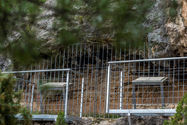
paintings
Located about 200 meters above a slight elevation, there are two shelters that contain cave paintings, with naturalistic images and hunting scenes. Objects such as baskets or vessels can be seen in the paintings. Animals with arrows can also be seen.
The time they were represented corresponds to the Neolithic period (4500 years BC), framing new settlers who settle in large caves, near watercourses, in the sunniest parts and located in height to monitor their territories.
HIS DISCOVERY
In the spring of April 1988, two explorers and scholars of medieval remains in the province of Castellón decided to visit Palanques. The researcher Vicente Forcada and his friend Antonio Hornero wanted to find possible medieval remains present in their municipal area. Homero, while touring the outskirts of Palanques, noticed a reddish stain that caught his attention. It was the cave painting of two large wild boars embodied in the rocky wall of a small shelter located very close to the town. Thus, by chance, some of the most important Levantine cave paintings in existence were discovered for the world. In the weeks following the surprising discovery, the most important archaeologists in Levantine rock art began to study them in detail. The Valencian archaeologist Norbert Mesado i Oliver was in charge of carrying out the meticulous study of them. Among many other things, he described unique cave figures that differentiate them from the rest of the cave art paintings of the Mediterranean arc of the Iberian Peninsula, such as the presence of a woman, a hunter holding a viper and a huge wild boar.
ITS IMPORTANCE
The naturalistic cave paintings of Cingle de Palanques belong to the Neolithic period. They are more than 5000 years old. They are made up of more than 30 figures made up of various groups of hunters and wild animals. The paintings are distributed between shelters called A and B, two very close caves.
In shelter A, located in a higher area of the mountain, two hunting scenes appear belonging to two different chronological horizons. The first period is made up of a group of three adult wild boars, two wild boars and a group of hunters who lie in wait for them. Among all the pictorial set, several figures stand out: the great hunter, a woman and a huge boar. The static hunter and chief of the tribe holds a bow with his right hand while with the index finger of his left hand he gives an order to a group of hunters. At his side is probably the most important figure in the pictorial ensemble: a small woman, shrunken and with elbowed arms in a clear attitude of submission to the great hunting chief. The archaeologist, Norbert Mesado, points out that it may be the boss's wife. It is one of the very few female figures that appear in all Levantine cave art, hence its enormous importance. Finally, the third outstanding painting in the cavity is a huge wild boar wounded by multiple arrows. It is one of the largest boars that exist in the group of Levantine cave paintings.
In shelter B, located to the left of A and in a lower part of the mountain, there is a very important and unique figure within the Levantine pictorial ensemble. It is the image of a hunter holding a bow in a shooting position and holding a long-snouted viper (Vipera latastei) on his arm. Painting is of extraordinary importance. Neolithic hunters poisoned the tips of arrows with the venom of vipers. In this way, when they managed to stick their poisoned tips into the body of the animals, they gradually fell asleep due to the effect of the poison. Later they followed his trail and managed to end his life in a faster and more efficient way.
HOW TO GET
Access to the Cingle de Palanques shelters starts from the center of the town. It is a simple and pleasant walk. We will go to the church square and from there to the Bergantes viewpoint, a splendid place to have a general view of the neighboring town of Sorita and the meander that the Bergantes river draws as it passes through Palanques. We will pass by the side of the cemetery and we will go to the top of the cingle where we will discover the demolished remains of a tower and a dry stone wall. From the highest point of this area known as el Romeral we will descend about 60 meters to the southeast. We will pass through several shelters without prehistoric remains to finally reach the two protected rock shelters.

























